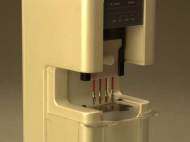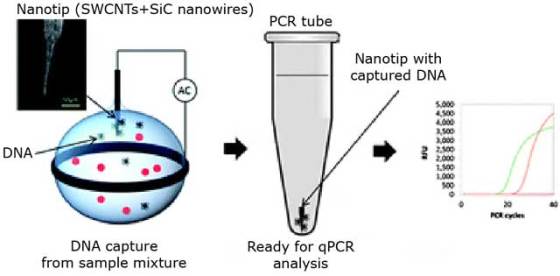Extracting human DNA with full genetic data within minutes
 Collaboration between engineers at the University of Washington (UW) and NanoFacture, a UW spinout company, resulted in the development of a device that can extract human DNA in a simpler, more efficient and environmentally friendlier way than conventional methods. The new device will enable hospitals and research labs to extract DNA from human fluid samples much easier, accelerating genome sequencing, disease diagnosis and forensic investigations.
Collaboration between engineers at the University of Washington (UW) and NanoFacture, a UW spinout company, resulted in the development of a device that can extract human DNA in a simpler, more efficient and environmentally friendlier way than conventional methods. The new device will enable hospitals and research labs to extract DNA from human fluid samples much easier, accelerating genome sequencing, disease diagnosis and forensic investigations.
Isolating DNA from bodily fluids is a very complex process and current procedures can be compared with collecting human hairs using a construction crane. Standard procedures use centrifuge to spin and separate DNA molecules or strain them from a fluid sample with a micro-filter, but these processes can require toxic chemicals and they require 20 to 30 minutes to complete.
The engineer team designed tiny probes called microscopic probes or microtips that dip into a fluid sample – saliva, sputum or blood – and apply electric field within the liquid. Consequently, particles concentrate around the surface of the microscopic probe. Unlike larger particles that hit the tip and turn away, DNA-sized molecules stick to the probe and are trapped on the surface. Using this technology DNA molecules are separated and purified within two or three minutes.
This portable device can purify four separate human fluid samples at once, but the technology can be scaled up to prepare batches of 96 samples at a time, which is standard for large-scale handling.
“The tiny probes, called microtips and nanotips, were designed and built at the UW in a micro-fabrication facility where a technician can make up to 1 million tips in a year, which is key in proving that large-scale production is feasible”, said Jae-Hyun Chung, UW associate professor of mechanical engineering who led the research.
More than 45,000 research laboratories worldwide conduct research that requires DNA preparation, driving a $3 billion global market for sample preparation devices and disposables in 2013. The development of this device will lead to faster and more affordable DNA sampling.
UW researchers have also designed a smaller version of the device which is the size of a pencil. Patients can use this device on their own at home. They could swab their cheeks, collect a saliva sample and then process their DNA on the spot and send back sample to hospitals for further analysis.
Thanks to this tiny device we could be one step closer to sequencing each person’s genome. However, the market demand for this device isn’t substantial at the moment, but Chung’s team will be ready when it is. On the other hand, the larger device is ready for manufacturing and distribution to hospitals and labs.
For more information, read the paper published in Analyst: “Nanotips for single-step preparation of DNA for qPCR analysis”.










Leave your response!